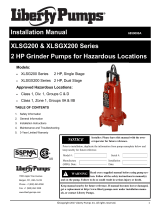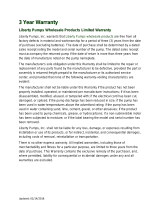
©Copyright 2015 Liberty Pumps Inc. All rights reserved 7
Fig. 5 – Direct Wiring of 115V or 208-230V,
Single Phase, Automatic Pumps
Fig. 4 Piggyback plug installation.
All LE-Series "A" models (automatic pumps) come factory-
equipped with a float switch mounted to the pump. These
models come with two cords - one to the float switch and the
other to the pump motor. The switch cord has a series
(piggyback) plug enabling the pump (motor) cord to be
plugged into the back of it (see Fig. 4). The purpose of this
design is to allow manual operation of the pump.
Prior to pump installation ensure that the mounting bracket
bolt is tight.
For automatic operation using Liberty's supplied switch, the two cords should be interconnected and plugged into a separately fused,
grounded outlet of proper amp capacity for your selected pump model. (See Section 1, General Information, or the pump nameplate for
electrical specifications of your model.) Both cords are equipped with 3-prong plugs and must be plugged into a properly grounded 3-
wire receptacle. DO NOT REMOVE THE GROUND PRONGS.
For manual operation, or in the event of switch failure, the pump cord can be separated and plugged into the electrical outlet, directly
bypassing the switch. 208-230V single phase pumps should only be operated without the float switch by using the circuit breaker or
panel disconnect. Do not let the pump run dry for extended periods.
The turn-on level of LE-Series "A" models is approximately 12" to 16" above the bottom of the basin. The turn-off level is approximately
6" above the bottom of the basin. Other pumping differentials may be obtained by tethering the switch cord to the discharge pipe.
NOTE: With wide angle floats, a minimum cord length of 3.5" from the tether point to the top surface of the float is required for proper
switch operation. If using a differential other than the factory setting, be sure when the pump shuts off at least 6" of fluid is left in the
basin so the impeller remains submerged.
NOTE: If the factory-mounted float is removed from the pump for relocation to the discharge pipe, be sure to replace and properly
tighten the mounting bracket bolt in the pump as it is also used to secure the volute.
LE-Series pump models with an "M" designation are manual models with no switch. They are intended to be run using an approved
liquid level control or approved motor control with correct rating that matches motor input in full load amperes. 3-phase models require
the use of an approved motor control that matches motor input in full load amperes with overload element(s) selected or adjusted in
accordance with control instructions.
Automatic operation with optional control devices: If the pump(s) are to be operated by either a simplex or duplex control panel, or
other optional control device, follow the installation instructions provided with your specific control and make the power connections per
those instructions. If necessary, certain models may be run without a separate control. 208-230V single-phase pumps should only be
operated without the float switch by using the circuit breaker or panel disconnect. Do not let the pump run dry for extended periods.
LE-Series "A" and "M" models: If the pump is to be wired directly into a control device or junction box, and it is necessary to remove
the plugs, have a certified electrician do the wiring in accordance with the National Electric Code and applicable local codes. See Fig. 5
for direct wire installation of single phase, automatic pumps.
In 208-230V installations, one side on
the line going to the pump is always
“hot”, whether the float switch is on or
off. To avoid hazards, install a double
pole disconnect near the pump
installation.
Figure C – Direct wiring of 115V or 208-230V, single
phase, automatic pumps.















